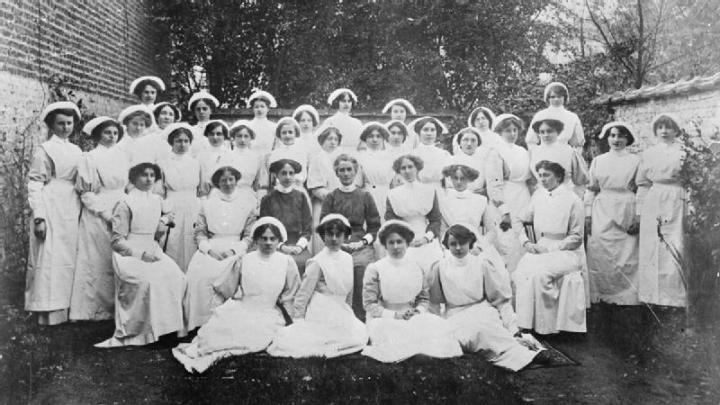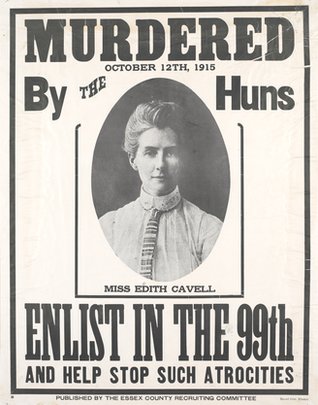Edith Cavell died at dawn on 12 October 1915 at Tir National firing range, Brussels. Her statue, near Trafalgar Square, London, England, bears the words she spoke the night before her death; ‘Patriotism is not enough, I must have no hatred or bitterness for anyone.’ There are few statues of non-royal women in the country and the fact that there is one of Edith, and in such a prominent position, demonstrates the impact her death had during wartime. Her sacrifice for others radiated the calibre of a woman who not only nursed allies and enemies alike but also helped around 200 allied soldiers escape war-torn Belgium.
Edith Cavell was born on 4 December 1865 and was a rector’s daughter from Swardeston, near Norwich, England. She had worked as a governess in Belgium before deciding to train as a nurse in London. She then worked in several English city hospitals before accepting the post of matron at Belgium’s first training hospital and nursing school. She was at the vanguard of nursing in Belgium and is rightly seen as a pioneer of modern nursing in that country.

She was on a return visit to Norfolk to visit her mother when war broke out in 1914 and against her family’s wishes, she returned to occupied Belgium to assist with the war effort.
Edith’s nursing school in Brussels became a Red Cross hospital and it was here that she nursed injured soldiers back to health. Unbeknownst to her nursing colleagues, she was part of a network of people who aided and abetted allied soldiers and civilians to leave Belgium, some of whom would enlist in allied forces and return to try to free their country. During the summer of 1915, she came under suspicion and was finally arrested on 5 August. She was held in solitary confinement in St Gilles Prison, Brussels. Her two-day trial began on 7 October 1915 as one of 35 cohorts accused of conspiring against Germany.
She was informed of her impending death the night before her execution. It was hoped that a swift dispatch by firing squad would avoid the story escaping out of Belgium. However, this plan failed and her execution was a PR disaster for the Germans, whilst what was seen as her heroism and martyrdom led to renewed anti-German sentiment in America prior to their participation in the conflict. Interventions by America and neutral Spain before her death failed to change German minds and there was global condemnation and outrage at Edith’s murder. In Britain, her image was used for wartime propaganda and recruitment drives and her death was credited with an upsurge of enlistment during late 1915.

In 1919, her body was exhumed so that she could be reburied on British soil. After a Westminster Abbey memorial, she was buried in the grounds of Norwich Cathedral.
Source:
https://www.bbc.co.uk/news/uk-england-norfolk-34401643
https://www.cavellnursestrust.org/edith-cavell
https://www.iwm.org.uk/history/who-was-edith-cavell
https://www.cathedral.org.uk/about/news/detail/2016/05/16/edith-cavell%27s-new-grave-dedicated
http://www.bbc.co.uk/schools/0/ww1/25405400




Very interesting story. Thanks for sharing.
LikeLiked by 2 people
That is quite tragic! At least she hasn’t been forgotten.
LikeLiked by 1 person
It is. I was miffed that I had a disrepectful pigeon on her head in my photo! There’s a mountain named after her in Canada and a nursing charity in her name.
LikeLiked by 1 person
Rude pigeon!
LikeLiked by 1 person
A heroic story. I’ve been to Mt Edith Cavell in the Rockies, it’s very distinctive. I can’t say i’ve climbed it (it’s huge) but i’ve been on the “nursery slopes”.
LikeLiked by 1 person
That’s amazing! I did look at pictures online. Even though this post had been planned for about a month (I still failed to complete it until yesterday evening) I was told this week I’ll be working in Norwich next week so I may make it to the cathedral to photograph her grave.
LikeLike
Interesting!
LikeLiked by 1 person
She was a brave lady. Thanks for sharing.
LikeLike
Very interesting. Hadn’t come across this story before… thanks for writing about her
LikeLiked by 1 person
You’re welcome. Thanks for reading and commenting. 🙂
LikeLike
Wow! Sad topic, but great piece of history!
LikeLiked by 1 person
This is an amazing piece. I love stuff like this because there are so many sacrifices made by so many people who history has completely forgotten. It is so nice to see that this brave woman has not been.
LikeLiked by 1 person
Thank you. So many stories yet to be told about historic women who accomplished by their own merit!
LikeLiked by 1 person
I have included your blog in INTERESTING BLOGS in FRIDAY FOSSICKING at
https://thatmomentintime-crissouli.blogspot.com/2018/10/friday-fossicking-19th-oct-2018.html
Thank you, Chris
I’m a long time admirers of Edith Cavell’s bravery, especially as she was well aware of the extreme risks, yet she gave her life for the freedom of others.
LikeLiked by 1 person
Thanks! I visited her grave this week at Norwich Cathedral.
LikeLiked by 1 person
Reblogged this on Life with Leukaemia & Beyond and commented:
If like me you’re interested in history, particularly WW1, this is such an inspirational & interesting story
LikeLiked by 1 person
Thanks so much 😁
LikeLiked by 1 person
You’re welcome 😊
LikeLiked by 1 person
Very interesting piece of history! I’ve never seen her statue before but it is quite a powerful image, and now especially so knowing her background.
LikeLiked by 1 person